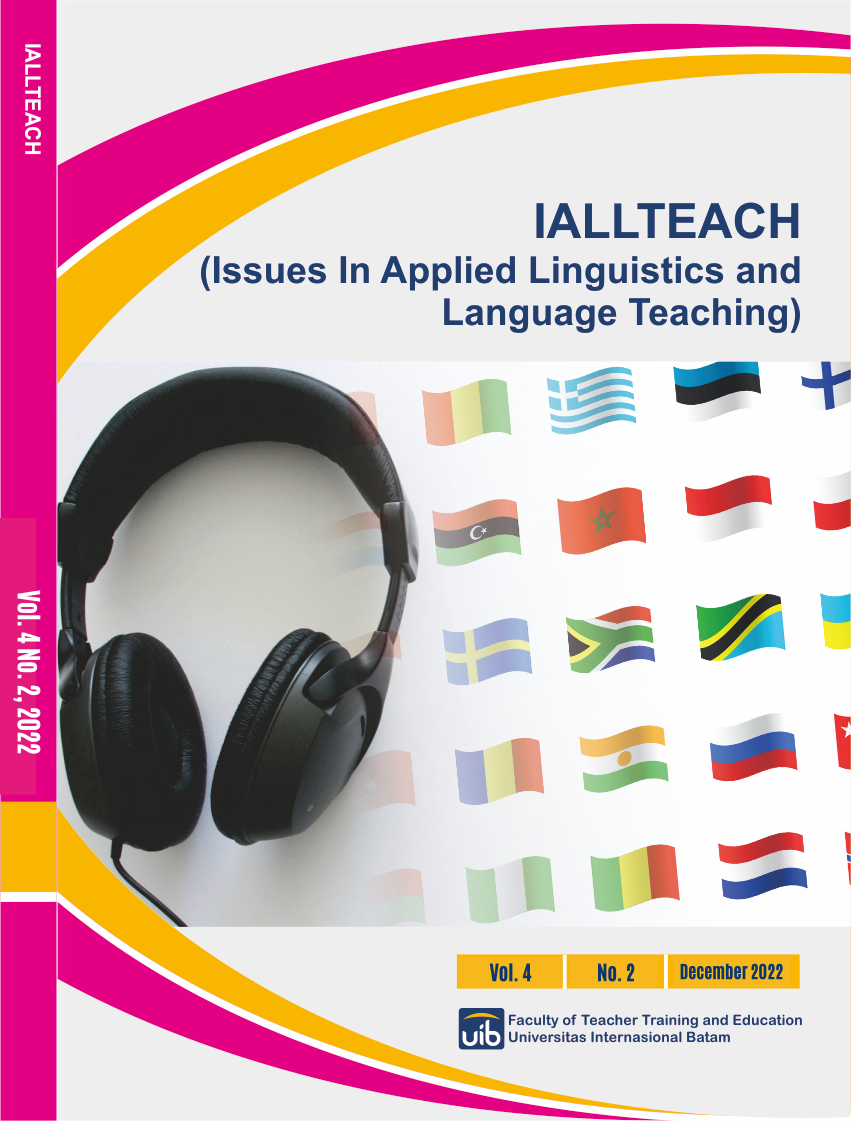Students’ Perception of Learning English with E-Learning During Covid-19 Pandemic
DOI:
https://doi.org/10.37253/iallteach.v5i1.7837Keywords:
E-Learning, Learning Management Systems, UIB Students, Perception, DifficultiesAbstract
This study aims to find out the perceptions and difficulties of Univesitas Internasional Batam students in learning English online using E-Learning (Learning Management System), what are the difficult factors that affect UIB students in learning using E-Learning during the Covid-19 pandemic. This research was conducted using quantitative methods. Participants in this study were Universitas Internasional Batam students totaling 100 students from the 2019-2021 batch from various majors. Data was obtained by using a questionnaire. To evaluate the data, the researcher used a Likert scale and categorizes it in the form of strongly agree, agree, disagree, and strongly disagree.
The results of the perception of this study indicate that most of UIB students have a very positive perception with the use of E-Learning in online English learning during the Covid-19 pandemic, this is supported by the perception factor from question no 9 that the learning materials in UIB's E-Learning are easy accessed anywhere, the average of these questions is 3.49. However, from the results of this study, there were 5 difficulty factors that affected UIB students, namely (1) question 15: low motivation statements when studying online using E-Learning with an average data of 2.77. (2) question 12: statement of lack of understanding about E-Learning features with an average data of 2.57. (3) question 20: statement of increasing internet quota on the use of E-Learning with an average data of 2.48. (4) question 18: statement Using E-Learning to learn English during this pandemic is uncomfortable with an average of 2.29. (5) question 19: the statement that it is difficult to access the internet network at E-Learning sites with an average data rate of 2.27.
Downloads
References
Chua Chine Nee, M. M. Y. (2020). RollRoll Dice: An Effective Method to Improve Writing Skills among Year 3 Pupils in Constructing SVOA Sentences. Universal Journal of Educational Research. https://doi.org/10.13189/ujer.2020.080621
Dawson, D. C. (2002). Practical Research Methods (A user-friendly guide to mastering research techniques and projects). Cromwell Press.
Gusti, I. (2016). Pengaruh Motivasi Belajar Terhadap Hasil Belajar Siswa Kelas XI Pada Mata Pelajaran Menggambar Bangunan SMK Negeri 1 Seyegan.
IGA ANGGRAINI. (2021). STUDENTS’ PERCEPTIONS OF ONLINE LEARNING ENGLISH DURING THE COVID-19 PANDEMIC [UNIVERSITAS ISLAM NEGERI SULTHAN THAHA SAIFUDDIN]. http://repository.uinjambi.ac.id/7098/1/TE161734 Students%27 Perceptions Of Online Learning English During The Covid-19 Pandemic - lampiran fulltext.pdf
Kriswanda Krishnapatria. (2020). FROM ‘LOCKDOWN’ TO LETDOWN: STUDENTS’ PERCEPTION OF E-LEARNING AMID THE COVID-19 OUTBREAK. 3(1). https://doi.org/10.35706/eltinfc.v3i1.3694
kudos. (2002). kudos on ?What is e-learning?? http://www.kudos-idd.com/learning_solutions/definition)
Lisa Rakhmanina, Feny Martina, F. B., & Halolo, Syafryadin, N. (2020). STUDENTS’ PERCEPTION ON ONLINE ENGLISH LEARNING DURING COVID-19 PANDEMIC ERA [Universitas Bengkulu]. https://doi.org/https://doi.org/10.31540/silamparibisa.v3i2
Marzuki, H2, I. Y., & Malik, A. R. (2021). KESULITAN GURU BAHASA INGGRIS DALAM MENGGUNAKAN E- LEARNING SELAMA PANDEMI COVID-19. 4. https://doi.org/: https://doi.org/10.31539/kibasp.v4i2.1693
Nurhakiki, N., & Sari, S. Y. (2021). Students’ perception on online english learning during covid-19 pandemic at junior high schools. English Language Teaching.
Pranoto, A. (2009). Sains and teknologi (PT Gramedia Pustaka Utama (ed.)).
Roberts, P.W. and Dowling, G. R. (2002). Corporate Reputation and Sustained Superior Financial Performance. American Journal of Industrial and Business Management, Vol.10 No. https://doi.org/https://doi.org/10.1002/smj.274
Sarmigi, E. (2020). Analisis Pengaruh Covid-19 Terhadap Perkembangan UMKM Di Kabupaten Kerinci. Al-Dzahab, 1(1), 1–17.
Septi Riyani, Bony Irawan, E. O. (2022). PROBLEMATIKA PENGGUNAAN LEARNING MANAGEMENT SYSTEM BERBASIS GOOGLE CLASSROOM DAN E-LEARNING SEBAGAI MEDIA PEMBELAJARAN ONLINE KELAS XI IPA MAN TANJUNGPINANG. (JPB) Jurnal Pembelajaran Biologi: Kajian Biologi Dan Pembelajarannya, 9. htpp://ejournal.unsri.ac.id/index.php/fpb
Sugiyono. (2016). Metode Penelitian Kuantitatif Kualitatif dan R&D. Alfabeta.
Sugiyono. (2017). Metode Penelitian Pendidikan : Pendekatan Kuantitatif, Kualitatif, dan R&D. Alfabeta.
Suhaemy, I. S. (2014). Perbedaan E-Learning dan Online Learning.
Taherdoost, H. (2019). What Is the Best Response Scale for Survey and Questionnaire Design; Review of Different Lengths of Rating Scale / Attitude Scale / Likert Scale. International Journal of Academic Research in Management (IJARM).
Valunaite Oleskeviciene, G., & Sliogeriene, J. (2020). Research methodology. In Numanities - Arts




.png)






